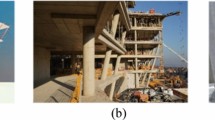Abstract
The use of base isolation to protect a structure and its contents from earthquake damage has proven to be an effective anti-seismic strategy during past earthquakes. Modelling of the isolation system is one of the key steps in understanding the response of the structure and more importantly to evaluate the effectiveness of the isolation system. This paper presents a study on the effect of damping in an isolation system using a linear spring and linear viscous damper to model the response of the isolated superstructure. Although this model may not be representative of the mechanical behaviour of a real isolation system, most nonlinear systems can be linearised in some form to provide an estimate to the response and thus the use of this model in this study. From the floor response spectra of the roof mass, the increase in damping in the isolation system leads to the excitation of response in higher modes. The floor response spectra also show that the effectiveness of isolation reduces with increasing damping in the isolation system and could be detrimental to the contents of the building. The bilinear model, also the basis of design codes such as the ASCE 7-16, is used in this study to model isolators. The analysis using the bilinear model with various design scenarios shows that the model delivers a significant amount of damping into the system when the system is experiencing regular intensity earthquake events. The presence of a high damping ratio in the isolation system, as in the linear model, excites the higher modes thus counteracts the objective of base isolating a structure. The paper concludes with a comparison of the isolator displacement estimated using the design code and the average response obtained through dynamic analyses. The difference between the displacement values is not large.

















Similar content being viewed by others
References
Charleson AW, Guisasola A (2015) Seismic isolation for architects. In: New Zealand Society for Earthquake Engineering (NZSEE) conference, Rotorua
Chopra AK (2012) Dynamics of structures—theory and applications to earthquake engineering, 4th edn. Pearson Education Inc., Upper Saddle River
Kelly JM (1997) Earthquake-resistant design with rubber. Springer, London
Lee JJ (2018) The potential application of strain-induced stiffening base isolation system. Doctoral dissertation, University of California, Berkeley
Filiatrault A, Tremblay R, Christopoulos C, Folz B, Pettinga D (2013) Elements of earthquake engineering and structural dynamics, 3rd edn. Presses Internationales Polytechnique, Montréal
American Society of Civil Engineers (2016) ASCE standard. American Society of Civil Engineers, Virginia, Reston
Beards CF (1996) Structural vibration: analysis and damping. Wiley, New York
Clough RW, Penzien J (2003) Dynamics of structures, 3rd edn. Computers & Structures Inc., Berkeley
Connor J, Laflamme S (2014) Structural motion engineering. Springer, Switzerland
Liang Z, Lee GC, Dargush GF, Song J (2012) Structural damping: applications in seismic response modification. CRC Press, Boca Raton
Acknowledgements
The work carried out in this study was part of a research work for a Doctoral Degree awarded at the University of California, Berkeley. The doctoral study was made possible with the scholarship provided by the Malaysian Rubber Board and 2018 Summer Fellowship provided by the Department of Civil and Environmental Engineering, University of California, Berkeley.
Author information
Authors and Affiliations
Corresponding author
Additional information
Publisher's Note
Springer Nature remains neutral with regard to jurisdictional claims in published maps and institutional affiliations.
Rights and permissions
About this article
Cite this article
Lee, J.J., Kelly, J.M. The effect of damping in isolation system on the performance of base-isolated system. J Rubber Res 22, 77–89 (2019). https://doi.org/10.1007/s42464-019-00012-z
Received:
Accepted:
Published:
Issue Date:
DOI: https://doi.org/10.1007/s42464-019-00012-z




